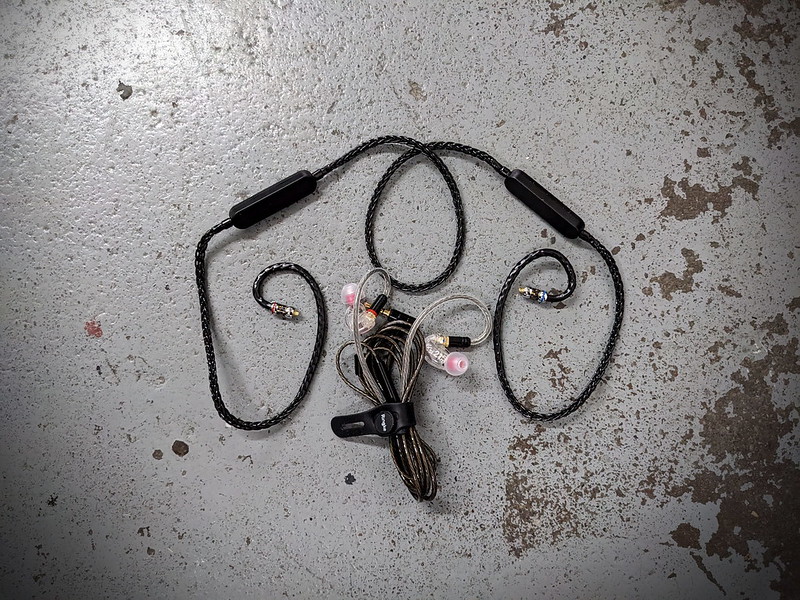How I Audio: Mobile Edition
I do not regularly listen to audio of any sort outside of home or the office. But I value the ability to do so, so I always carry earbuds in my bag. As with headphones, the cable is the usual failure point. The solution, once again, is modularity.
Specifically, I recommend skipping the entire consumer earbud category and going straight to “professional” in-ear monitors.
I carry Shure SE215 IEMs. These are near the bottom-end of the IEM market. I’ve heard people claim that paying hundreds, or thousands, of dollars for custom-molded IEMs is worth it. I’ve heard other people claim that the Chi-Fi market now offers IEMs that are cheaper than the SE215s and yet provide better audio quality. To my non-discerning ears, the SE215s sound great, and they satisfy my listening and comfort requirements. But more important than the specific make or model is that most products in this market segment will offer replaceable cables. The SE215s use an MMCX connector.
For portable use, I want a cable with an inline mic (and 3-button remote) so that I have the option of using it to go hands free with my pocket telephone. Shure sells IEMs with such a cable. This cable failed for me after a couple years. Fortunately, the Chinese Communist Party has realized Marx’s dream of a practically infinite supply of generic MMCX cables with inline mics for dirt cheap. I’m now using a cable I bought off AliExpress for about $10, and if I have to spend another $10 in another couple years I shan’t shed a tear. (If this was for more than occasional and incidental use, I would likely purchase something like the Antlion Kumura Cable or Kinera Gramr, but I’m not going to carry that sort of thing around in my bag just in case.)
I prefer silicone eartips when out and about in the world. They are long lasting and easy to clean. They don’t provide as much isolation as foam tips, but I consider that a feature rather than a bug; I don’t want to be cut off from the surrounding environment. (In special circumstances where I do actually want to block or diminish environmental sound, I use actual ear protection). My favorite tips are the Spinfit CP100+. The medium size feels good upon initial insertion, but I find the small size is more comfortable after a couple hours of continuous penetration.
As a general rule, I subscribe to the Kamala Harris School of Audio Peripherals, as documented in my favorite example of modern hard-hitting investigative journalism. Wireless is a trap. But I admit that there are times when a wireless connection is convenient and worth the additional hassle, however few and far between those times may be. With a modular system, this can easily be addressed by the addition of an adapter.
Originally I thought I might purchase something like the FiiO UTWS5 or Shure RMCE-TW2. But both of these utilize telephone software, which I’m allergic to, and I realized I didn’t actually understand what the sales pitch was for this new-fangled category of “true wireless” earbuds.
Instead, I ended up going back to AliExpress and purchasing a much cheaper necklace style adapter. This isn’t something I carry everyday, but it’s nice to have the option to grab it when plans warrant.
Bluetooth is the one component of the modern audio stack where the technology is still improving – or, at least, getting less bad – so using an interchangeable module here makes sense. The adapter I purchased is built on the Qualcomm QCC5181 chip, providing Bluetooth 5.4, which appears to still be the latest and greatest thing. Portable Bluetooth devices have a limited service life due to their integrated batteries, so again, modularity makes sense here. When these batteries fail, or when I determine it is worth updating to the latest chip, I just buy a new adapter rather than purchasing a whole new system. (It’d be great if we could buy adapters with replaceable batteries, but that seems to be a dream too far.)
If someday in the future I decide it is worth it to buy custom molded IEMs, I’ll just order them with an MMCX connector and they’ll be able to play nicely with my existing ecosystem of cables and adapters. This is the antithesis of the market trend and may result in the revocation of one’s listener license.







